https://edition.cnn.com/2018/05/22/health/michael-jackson-dance-moves/index.html
How Michael Jackson's tilt defied gravity
by Sandee LaMotte, CNN
Updated 1849 GMT (0249 HKT) May 22, 2018
Story highlights
- Michael Jackson created a dance move that defied gravity
- To accomplish it he patented a special shoe
(CNN)Michael Jackson's musical achievements are legend: the first artist to win eight Grammys in one night; the first artist to sell more than a million digital tracks in one week.
His impact on dance has been just as powerful. Fans around the world have tried to imitate his smooth slides and spins, his racy crotch grab and pelvic thrust and, of course, his trademark moonwalk, with varying degrees of success.
Sponsor Content
Dr. Bosch and Dr. de Sanjose have dedicated their lives to HPV cancer research. Here's their story.
Dr. Silvia de Sanjose and Dr. Xavier Bosch have dedicated their lives to HPV cancer research. Now they're sharing their story to educate others.
Content provided by MSD
Sponsor Content
Dr. Bosch and Dr. de Sanjose have dedicated their lives to HPV cancer research. Here's their story.
Dr. Silvia de Sanjose and Dr. Xavier Bosch have dedicated their lives to HPV cancer research. Now they're sharing their story to educate others.
Content provided by MSD
But there's one move that stunned the watching world: the gravity-defying tilt he debuted in his 1988 music video for "Smooth Criminal." In one scene, Jackson and a few of his dancers lean forward 45 degrees, backs straight, feet flat upon the floor, and hold the pose until they return upright with little apparent effort.
"It's not really possible physically to do it," said neurosurgeon Dr. Nishant Yagnick, a longtime Jackson fan who practices at the Postgraduate Institute of Medical Education and Research in Chandigarh, India. "He was cheating gravity."
"You can bend a maximum of 25 or 30 degrees forward before you fall on your face," added his colleague Dr. Manjul Tripathi, another fan. "I tried to do it, and I fell."
Fascinated by Jackson and his seemingly inhuman abilities, Yagnick and Tripathi began to investigate just how the pop legend was able to accomplish his feat. Along with another colleague, Dr. Sandeep Mohindra, they published their observations from a neurosurgeon's point of view on Tuesday in the Journal of Neurosurgery: "How did Michael Jackson challenge our understanding of spine biomechanics?"
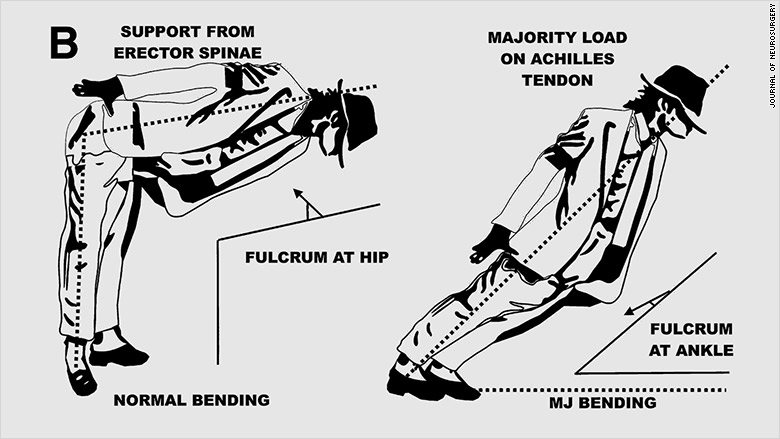
On the left, how the body is supposed to bend; on the right, how Michael Jackson did it
When the human body bends forward with the back straight, the doctors explain, the erector spinae muscles that run parallel to our vertebrae "act like cables" and support the body as the center of gravity shifts. But when the focus of bending is switched to the ankles, those erector muscles aren't the major support. Instead, the strain is put on the calf and Achilles tendon, which aren't really built for that role.
"This allows for a very limited degree of forward bending from the ankle joints, while keeping a stiff straight posture -- unless you are Michael Jackson," they explain in the study. "Most trained dancers with strong core strength will reach a maximum of 25 or 30 degrees of forward bending while performing this action."
Though Jackson was in marvelous shape, even he couldn't do the maneuver without help. So he and his team invented a special shoe that would anchor him to the floor during the tilt.
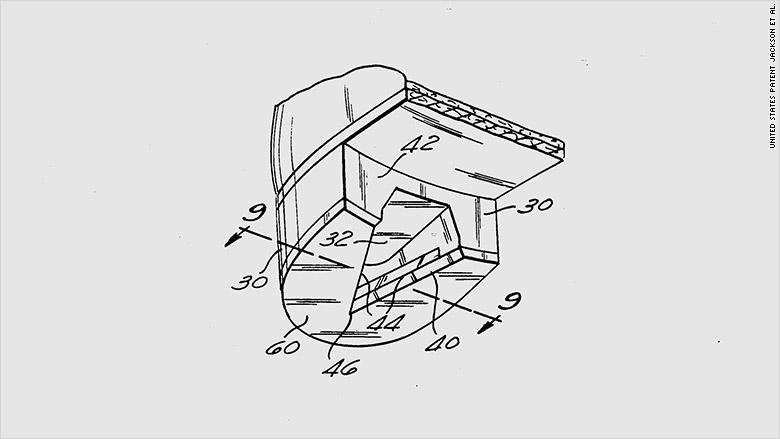
Michael Jackson's patented shoe.
Patented on October 26, 1993, the shoes "have a specially designed heel slot which can be detachably engaged" with a "hitch" (such as a nail) projected through the stage surface "by simply sliding the shoe wearer's foot forward, thereby engaging with the hitch member," according to the US Patent Office description.
"Very inventive idea of him," Tripathi said with a laugh, "because even with that shoe, I am not able to do 45 degrees. You need a very good core of strength, and that strength was in Michael Jackson and his Achilles tendon."
Yagnick agreed: "Normal people, even with the shoe, probably can't do it. It takes a lot of practice to develop the core muscles, abs and central trunk muscles to get the strength to do it."
Not only would most people need intensive training to accomplish the move, said Atlanta physiatrist Dr. Jose Garcia-Corrada, but they could seriously injure themselves if they fell. Garcia specializes in the medical rehabilitation of the spine at Emory School of Medicine.
"If you were to lose your core balance during the lean and didn't catch the fall with your arms, you could hit your jaw," Garcia-Corrada said. "That might hyperextend the neck and cause serious spine damage."
It's not just the spine that might be affected, he added.
"You're holding most of your weight with muscles that you normally wouldn't use in this way," he said. "You could really strain your back and legs muscles and tendons."
Many audiences who watched Jackson and his dancers perform the feat on video and in concerts had no knowledge of the trick. To them, Yagnick said, it seemed like magic.
"When Michael Jackson brought out the video and then did it live on stages around the world, people didn't know he had this shoe system," he said. "Particularly in India, where Michael Jackson is very popular, many people tried to copy him, and some even hurt themselves."
"MJ style," as it is called in India, is so popular that one of the top dance groups is called "MJ5" because they imitate Jackson, while children emulate the moves in competitions like "Dance, India, Dance."
Tripathi believes that Jackson's legacy has "pushed whole generations of dancers to go beyond their limits," which he says is putting new kinds of stresses on the spine. "So in India, neurosurgeons are perplexed due to all these new kinds of neuroskeletal injuries we are now seeing."
Studies on the newer forms of dance inspired by Jackson back up the doctors' observations.
A 2012 study published in the Scandinavian Journal of Medicine and Science in Sports followed three types of hip-hop dancers: popper/lockers, breakers and "new schoolers."
Popping and locking are foreshadowed in many of Michael Jackson's routines. Locking requires freezing from a fast movement and "locking" into that position for a short time before suddenly moving again. Popping involves quickly contracting and relaxing muscles to produce a jerking motion or "pop" in the body.
Breakers or "B-boys" practice a highly acrobatic type of dance that involves tumbling, spinning headstands and lifts in which the entire body is supported by one arm. "New schoolers" borrow inspiration from many styles of dance and fit them to the music.
There were 738 injuries among the 232 dancers in the study; breakers had the highest number of injuries. The study's conclusion: Hip-hop dancers "should be educated concerning injury prevention, biomechanics, and use of protective equipment."
A 2009 study in the American Journal of Sports Medicine found 1,665 injuries among 40 breakdance professionals and 104 amateurs, mostly in the wrist, spine, shoulder and ankle. Breakdancing, said the authors, "must be considered as a potentially high-risk dancing sport," especially since dancers didn't often take enough time to heal before jumping back into training.
That is a significant problem in India as well, Yagnick said, particularly among young people who see dancing as a pathway to a profession.
"We are seeing a lot of complex dance moves that they just copy but don't really learn from a professional," Yagnick said. "They are young, 18 or younger, and they want to get ahead, and they are pushing themselves. They don't know what they are dealing with. There should be education on the right and wrong way to do things."
- Paid ContentMore from CNN
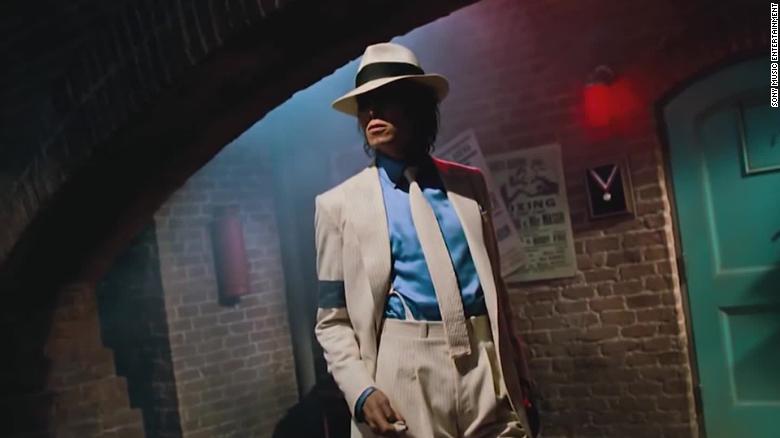






























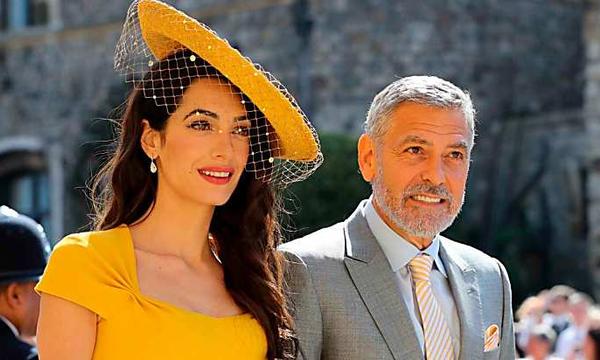




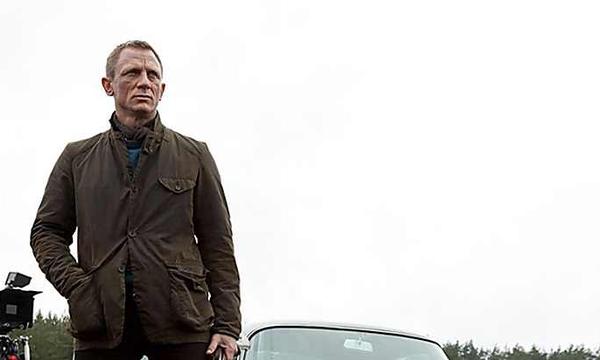



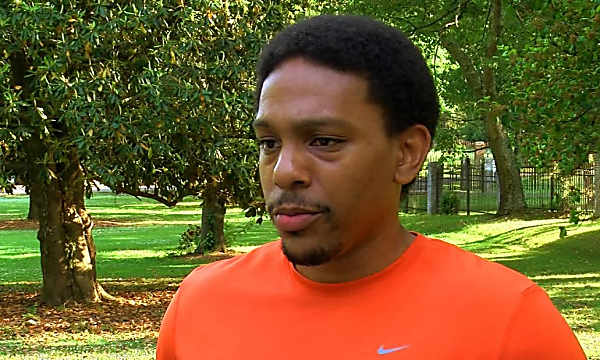








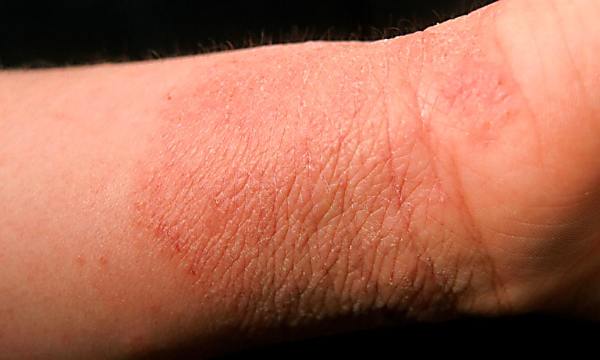










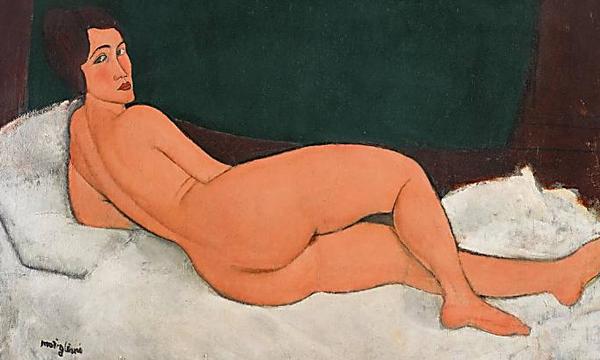
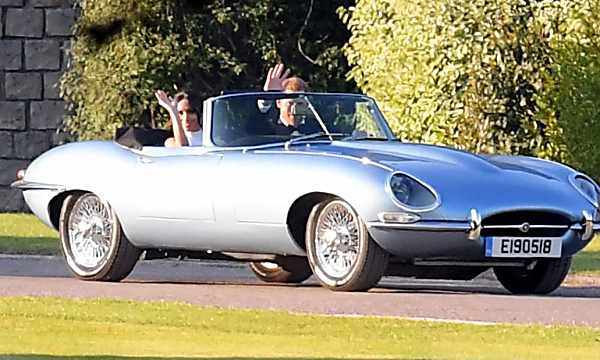
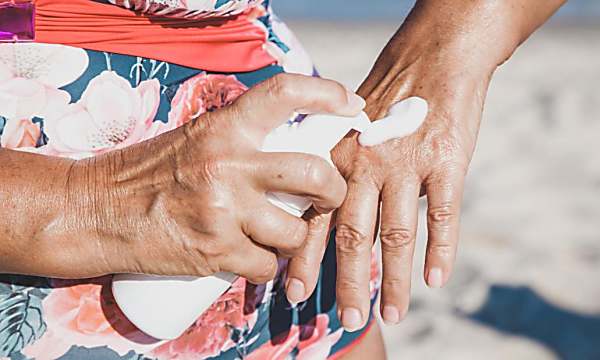














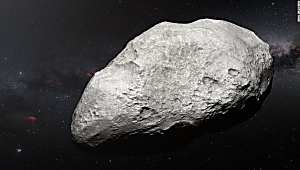


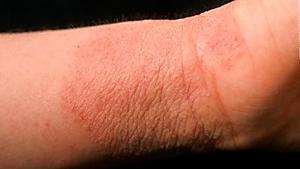
沒有留言:
張貼留言